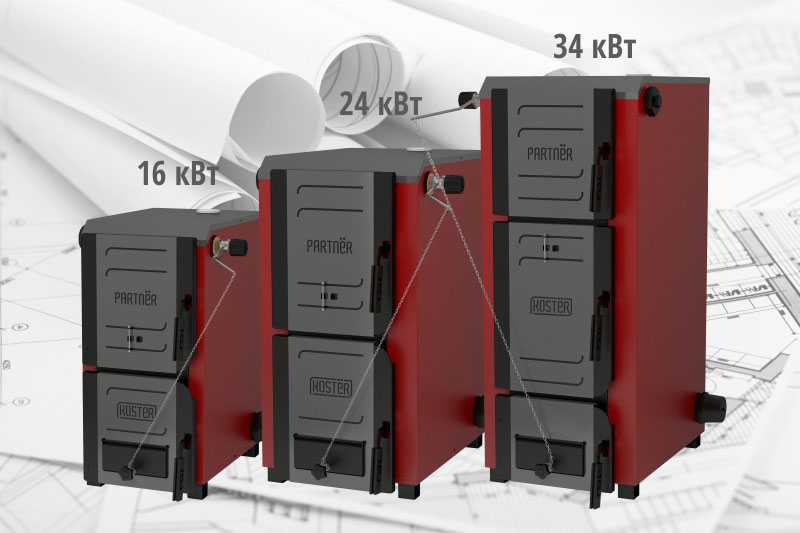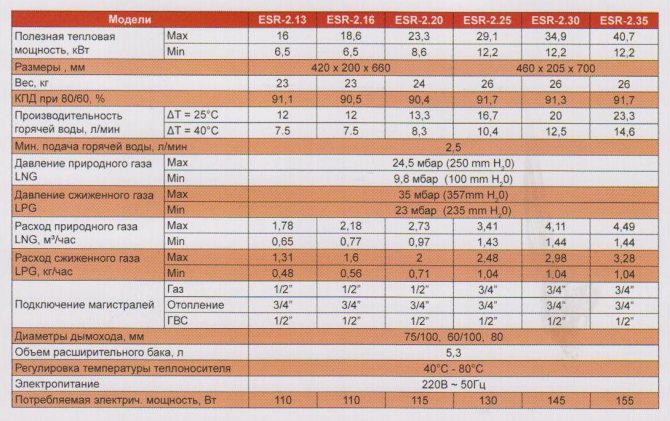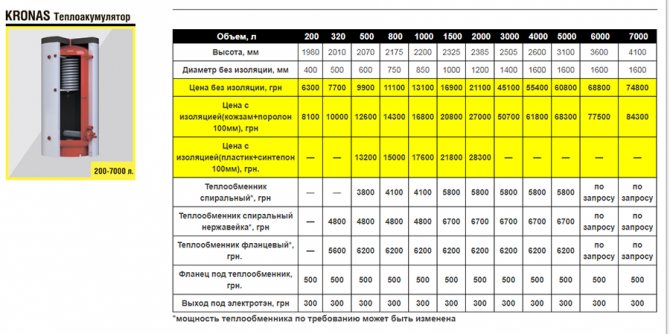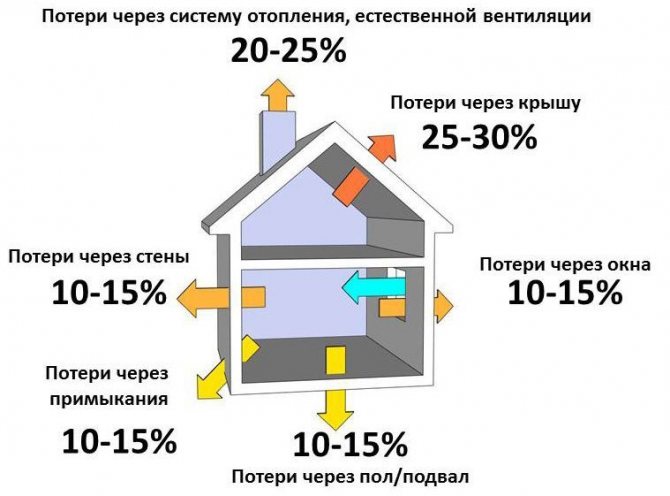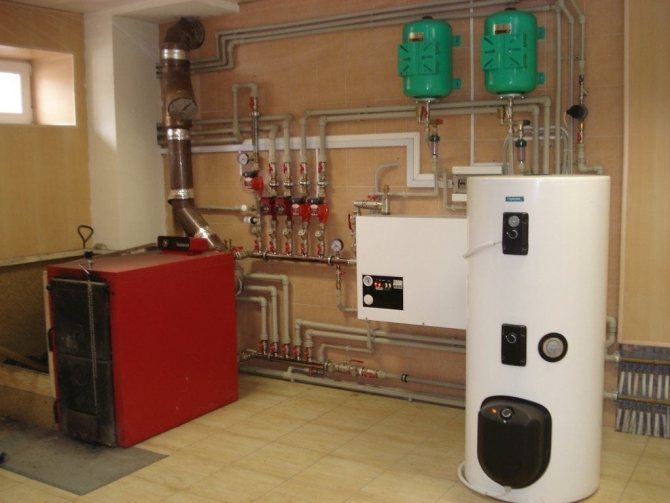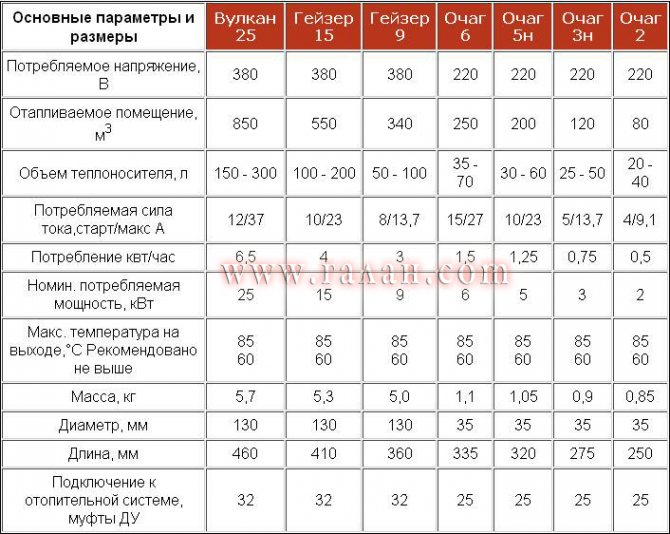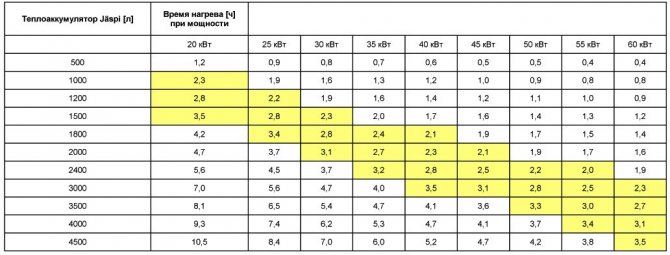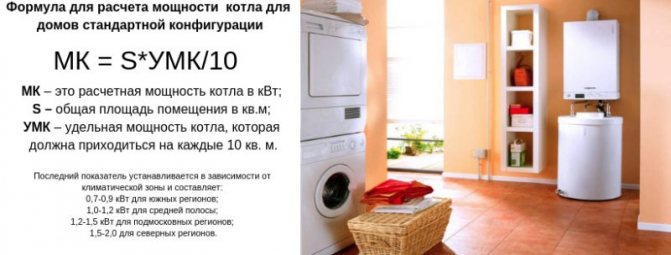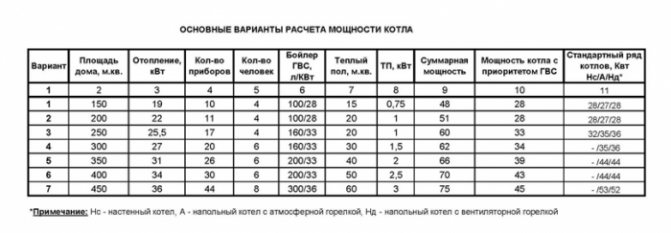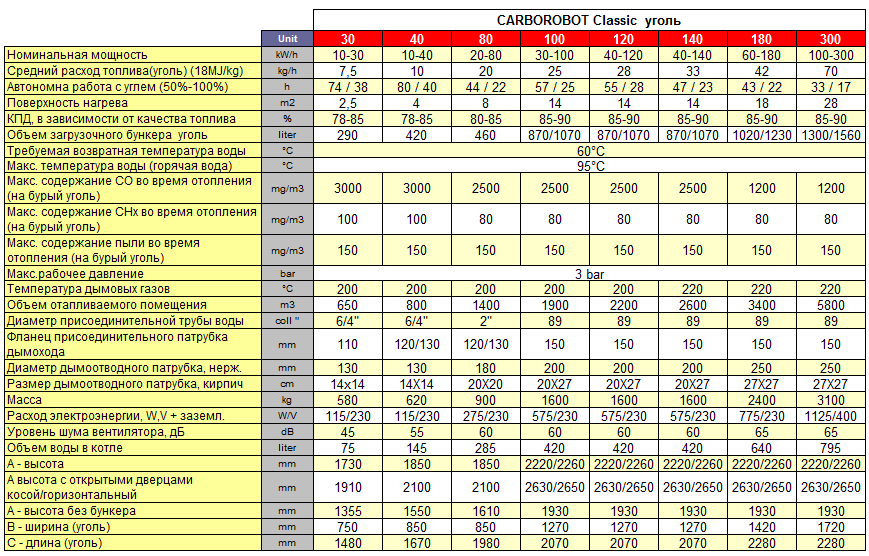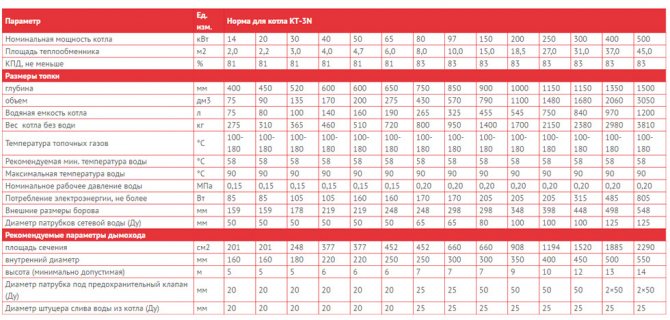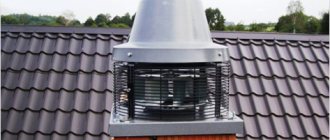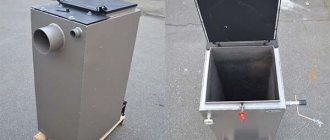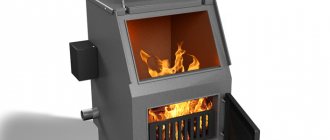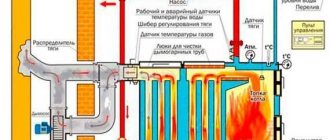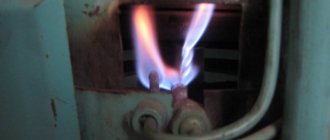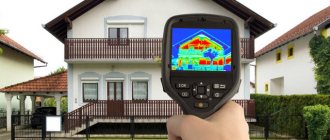In order to choose a solid fuel boiler, you need to pay attention to the power. This parameter shows how much heat a specific device can create when connected to the heating system. It directly depends on whether it is possible with the help of such equipment to provide the house with heat in the required amount or not.
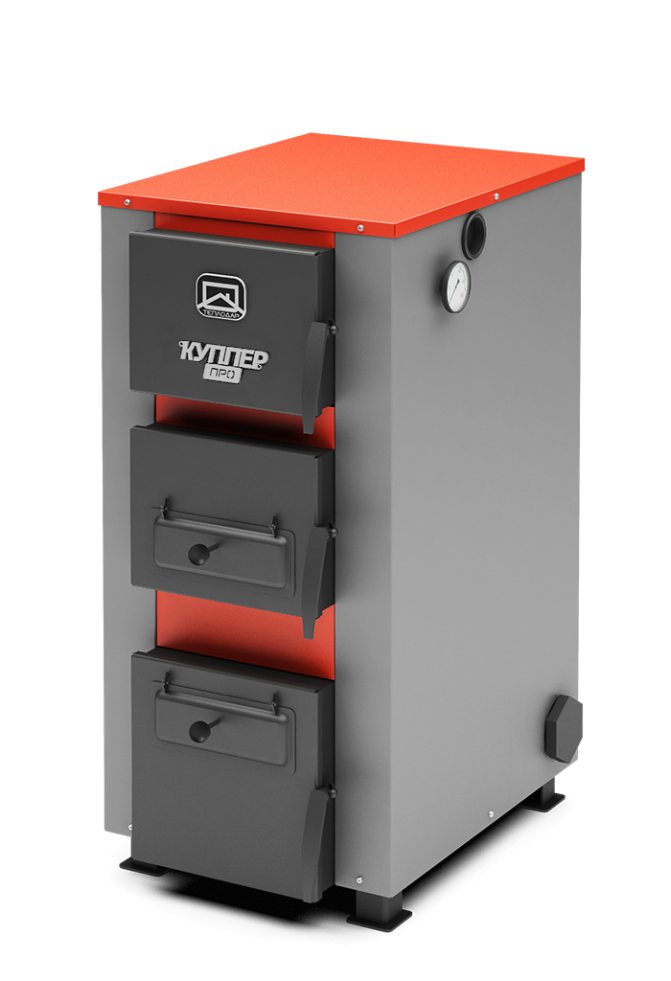
For example, in a room where a low-power pellet boiler is installed, it will be cool at best. Also, not the best option is to install a boiler with excess capacity, because it will constantly work in an economical mode, and this will significantly reduce the efficiency indicator.
So, in order to calculate the power of a boiler for heating a private house, you need to follow certain rules.
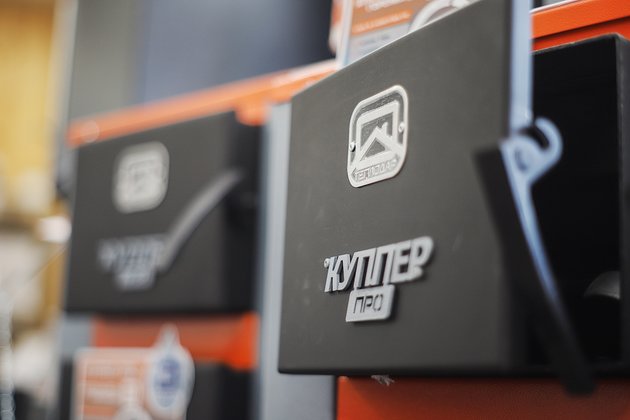

How to calculate the power of a heating boiler, knowing the volume of the heated room?
The heat output of the boiler is determined by the formula:
Q = V × ΔT × K / 850
- Q
- the amount of heat in kW / h - V
- the volume of the heated room in cubic meters - ΔT
- the difference between the temperature outside and inside the house - TO
- coefficient of heat loss - 850
- the number due to which the product of the above three parameters can be converted into kW / h
Indicator TO
can have the following meanings:
- 3-4 - if the structure of the building is simplified and wooden, or if it is made of profiled sheet
- 2-2.9 - the room has little thermal insulation. Such a room has a simple structure, the length of 1 brick is equal to the thickness of the wall, the windows and the roof have a simplified construction.
- 1-1.9 - the building structure is considered standard. These houses have a double brick tab and few simple windows. Roof roof ordinary
- 0.6-0.9 - the structure of the building is considered to be improved. Such a building has double glazed windows, the base of the floor is thick, the walls are brick and have double thermal insulation, the roof has thermal insulation made of good material.
Below is a situation in which a heating boiler is selected according to the volume of the heated room.
The house has an area of 200 m², the height of its walls is 3 m, the thermal insulation is first class. The ambient temperature near the house does not fall below -25 ° C. It turns out that ΔT = 20 - (-25) = 45 ° C. It turns out that in order to find out the amount of heat that is required to heat a house, you need to make the following calculation:
Q = 200 × 3 × 45 × 0.9 / 850 = 28.58 kWh
The result obtained should not yet be rounded off, because a hot water supply system can still be connected to the boiler.
If the water for washing is heated in a different way, then the result that was obtained independently does not need to be adjusted and this stage of the calculation is final.
How to calculate how much heat is needed to heat water?
To calculate the heat consumption in this case, it is necessary to independently add the heat consumption for hot water supply to the previous indicator. To calculate it, you can use the following formula:
Qw = s × m × Δt
- from
- specific heat of water, which is always equal to 4200 J / kg K, - m
- mass of water in kg - Δt
- the difference in temperature between the heated water and the incoming water from the water supply.
For example, the average family consumes 150 liters of warm water on average. The coolant that heats the boiler has a temperature of 80 ° C, and the temperature of the water coming from the water supply is 10 ° C, then Δt = 80 - 10 = 70 ° C.
Consequently:
Qw = 4200 × 150 × 70 = 44,100,000 J or 12.25 kW / h
Then you need to do the following:
- Suppose you need to heat 150 liters of water at a time, which means that the capacity of the indirect heat exchanger is 150 liters, therefore, 12.25 kW / h must be added to 28.58 kW / h.This is done because the Qzag indicator is less than 40.83, therefore, the room will be cooler than the expected 20 ° C.
- If the water is heated in portions, that is, the capacity of the indirect heat exchanger is 50 liters, the indicator 12.25 must be divided by 3 and then added independently to 28.58. After these calculations, Qzag is equal to 32.67 kW / h. The resulting indicator is the power of the boiler, which is needed to heat the room.
https://youtu.be/sm2yTOiXJZ8
Heat calculation for DHW
To calculate how much heat needs to be spent on heating water, you need to use the formula Qw = s * m * Δt:
- where c is specific heat of water (the indicator is always equal to 4200 J / kg * K);
- m - mass of water in kg;
- Δt temperature difference between heated water and supplied from the water supply.
Selection of a boiler by the area of a private house. How to make a calculation?
This calculation is more accurate because it takes into account a huge number of nuances. It is produced according to the following formula:
Q = 0.1 × S × k1 × k2 × k3 × k4 × k5 × k6 × k7
- 0.1 kW
- the rate of required heat per 1 m². - S
- the area of the room to be heated. - k1
shows the heat that has been lost due to the structure of the windows, and has the following indicators:
- 1.27 - single glass by the window
- 1.00 - double-glazed window
- 0.85 - triple glass by the window
- k2
shows the heat that has been lost due to the area of the window (Sw). Sw refers to the floor area Sf. Its indicators are as follows:
- 0.8 - at Sw / Sf = 0.1;
- 0.9 - at Sw / Sf = 0.2;
- 1.0 - at Sw / Sf = 0.3;
- 1.1 - at Sw / Sf = 0.4;
- 1.2 - at Sw / Sf = 0.5.
- k3
shows heat leakage through walls. Can be as follows:
- 1.27 - poor-quality thermal insulation
- 1 - the wall of the house is 2 bricks thick or insulation 15 cm thick
- 0.854 - good thermal insulation
- k4
shows the amount of heat lost due to the temperature outside the building. Has the following indicators:
- 0.7, when tz = -10 ° C;
- 0.9 for tz = -15 ° C;
- 1.1 for tz = -20 ° C;
- 1.3 for tz = -25 ° C;
- 1.5 for tz = -30 ° C.
- k5
shows how much heat is lost due to the outer walls. Has the following meanings:
- 1.1 in the building 1 outer wall
- 1.2 in the building 2 external walls
- 1.3 in the building 3 external walls
- 1.4 in the building 4 outer walls
- k6
shows the amount of heat that is needed additionally and depends on the height of the ceiling (H):
- 1 - for a ceiling height of 2.5 m;
- 1.05 - for a ceiling height of 3.0 m;
- 1.1 - for a ceiling height of 3.5 m;
- 1.15 - for a ceiling height of 4.0 m;
- 1.2 - for a ceiling height of 4.5 m.
- k7
shows how much heat has been lost. Depends on the type of building that is located above the heated room. Has the following indicators:
- 0.8 heated room;
- 0.9 warm attic;
- 1 cold attic.
As an example, we will take the same initial conditions, except for the parameter of windows, which have a triple glass unit and make up 30% of the floor area. The structure has 4 exterior walls and a cold attic above it.
Then the calculation will look like this:
Q = 0.1 x 200 x 0.85 x 1 x 0.854 x 1.3 x 1.4 x 1.05 x 1 = 27.74 kWh
This indicator must be increased, for this you need to independently add the amount of heat that is required for DHW if it is connected to the boiler.
If you do not need to perform accurate calculations, then you can use a universal table. With it, you can determine the power of the boiler by the area of the house. For example, a boiler with a capacity of 19 kW is suitable for heating a room of 150 sq m, and 200 sq m for heating. it will require 22 kW.
| Option | House area, sq.m. | Heating, kW | Number of devices | Number of people | DHW boiler, l / kW |
| 1 | 150 | 19 | 10 | 4 | 100/28 |
| 2 | 200 | 22 | 11 | 4 | 100/28 |
| 3 | 250 | 25,5 | 17 | 4 | 160/33 |
| 4 | 300 | 27 | 20 | 6 | 160/33 |
| 5 | 350 | 31 | 26 | 6 | 200/33 |
| 6 | 400 | 34 | 30 | 6 | 200/33 |
| 7 | 450 | 36 | 44 | 6 | 300/36 |
The above methods are very helpful in calculating the power of the boiler to heat the house.
Calculation methods
To maintain a comfortable temperature in living quarters, independently equipping the heating system, it is necessary to take into account the heat loss through the floor base, walls, ceiling, door and window structures. There must be a reserve of power in case of severe frosts.
By the volume of the heated area
Formula for calculating heat:
Q = V × ΔT × K / 850, where
- Q is the amount of heat energy, kW / h;
- V is the volume of the room, m³;
- ΔT is the temperature difference between the external and internal air environment;
- K - coefficient of heat energy loss;
- 850 is a constant number to convert to kWh.
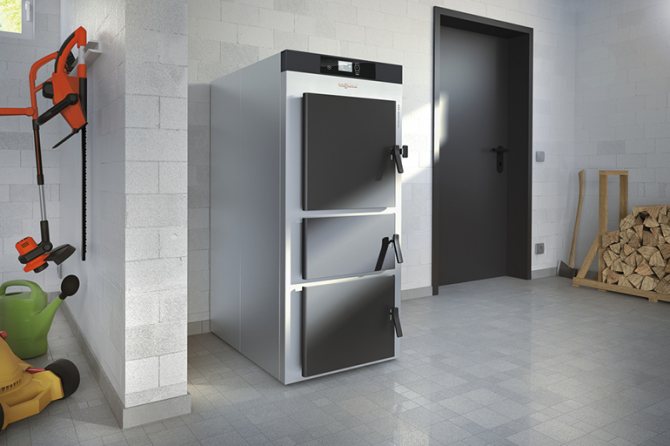

You can calculate the amount of heat by the volume of the heated area.
Thermal coefficient values for different objects:
- improved building structures (brick walls, thick floors, double-glazed windows in window openings, insulation is made in 2 layers) - K = 0.6-0.9;
- standard residential buildings - K = 1-1.9;
- simplified construction of houses with one layer of thermal insulation and standard windows - K = 2-2.9;
- wooden buildings - K = 3-4.
When calculating the required amount of heat for all living rooms of the house, it is necessary to take into account the heating of water for the consumer needs of the family.
By the area of the room
When calculating the amount of heat required for a room, many nuances are taken into account, so this method is more accurate.
Formula: Q = 0.1 × S × k1 × k2 × k3 ... .. k7, where
- thermal energy rate - 0.1 kW / m²;
- S is the area of the territory;
- k1 - indicator of losses through window structures (single glass unit - 1.27, double - 1, triple - 0.85);
- k2 is the heat consumption over the window area (Sw) relative to the floor area Sf (at Sw / Sf = 0.1, k2 = 0.8; respectively, 0.2 to 0.9; 0.3 to 1.0; 0 , 4 to 1.1 and 0.5 to 1.2);
- k3 - energy leakage through the walls of the room (when using low-quality insulating material - 1.27; using a material with a thickness of 15 cm or double brickwork - 1.0; for high-quality insulation - 0.854);
- k4 - heat loss due to external temperature (at T = -10 ° C, k4 = 0.7, respectively, -15 ° C to 0.9; -20 ° C to 1.1; -25 ° C to 1 , 3; -30 ° C to 1.5);
- k5 - energy costs due to 1 outer wall - 1.1; 2 - 1.2; 3 - 1.3; 4 - 1.4;
- k6 - additional amount of heat depending on the height of the ceiling of the room: H = 2.5 m, K = 1, respectively, 3 m to 1.05; 3.5m to 1.1; 4 m to 1.15; 4.5 m to 1.2;
- k7 - energy losses depending on the structure located above the heated room (cold attic - K = 1, insulated - 0.9, heated room - 0.8).


Many nuances are taken into account when performing the calculation.
For example, the building has 4 external walls, the window openings are equipped with triple glass units, the parameters of which are 30% in comparison with the floor area. There is a cold attic between the ceiling and the roof structure.
Calculation formula: Q = 0.1 × 200 × 0.85 × 1 × 0.854 × 1.3 × 1.4 × 1.05 × 1 = 27.74 kWh.
The resulting indicator is increased by the amount of thermal energy that is needed for hot water supply (if this system is connected to a solid fuel apparatus).
Calculation for a hot water boiler
This indicator is obtained using the following formula:
Qw = s × m × Δt, where
- Qv - energy required for a hot water boiler;
- c - specific heat capacity of the liquid (constant value equal to 4200 J / kg * K);
- m is the mass of water;
- Δt is the temperature difference between cold and heated liquid.
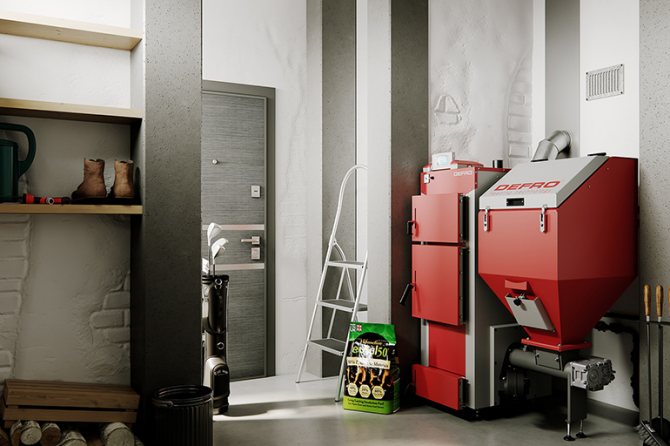

Incorrectly selected boiler power will lead to an increase in energy consumption.
For example, a family of 4 consumes 150 liters / day of hot water. The boiler is equipped with a heat carrier capable of heating liquid coming from a common communication system from T = 10 ° C to T = 80 ° C. In this case, the temperature difference Δt = 80 - 10 = 70 ° C.
We substitute all the values in the formula and we get:
Qw = 4200 J / kg * K × 150 kg × 70 ° C = 44,100,000 J (translated as 12.25 kW / h).
For example, you need to immediately heat up 150 liters of water for washing. Accordingly, the indirect heat exchanger has a capacity of 150 liters. Therefore, to 28.58 kW / h (energy consumption for the room), you need to additionally add 12.25 kW / h (water heating). In this case, the value of Qzag is lower than 40.83 kW / h, i.e. the air temperature in the rooms will be less than the calculated 20 ° C.
With batch heating of the liquid (capacity of the indirect heat exchanger = 50 l), the costs will be 12.25 kW / 3 = 4.08 kW / h. Accordingly, Qzag = 28.58 + 4.08 = 32.66 kW / h. This is the required power of heating equipment to maintain room temperature above 20 ° C and heat a container with water for domestic use.
Calculation of the real power of a long-burning boiler using the example of "Kupper PRACTIC-8"
The design of most boilers is designed for the specific type of fuel on which this device will operate.If a different category of fuel is used for the boiler, which is not reassigned for it, the efficiency will be significantly reduced. It is also necessary to remember about the possible consequences of using the fuel that is not provided by the manufacturer of the boiler equipment.
Now we will demonstrate the calculation process using the example of the Teplodar boiler, the Kupper PRACTIC-8 model. This equipment is intended for heating systems of residential buildings and other premises, which have an area of less than 80 m². Also, this boiler is universal and can work not only in closed heating systems, but also in open ones with forced circulation of the coolant. This boiler has the following technical characteristics:
- the ability to use firewood as fuel;
- on average per hour, he burns 10 firewood;
- the power of this boiler is 80 kW;
- the loading chamber has a volume of 300 liters;
- The efficiency is 85%.
Suppose that the owner uses aspen wood as fuel to heat the room. 1 kg of this type of firewood gives 2.82 kWh. In one hour, the boiler consumes 15 kg of firewood, therefore, it produces heat 2.82 × 15 × 0.87 = 36.801 kWh of heat (0.87 is the efficiency).
This equipment is not enough for heating a room that has a heat exchanger with a volume of 150 liters, but if the DHW has a heat exchanger with a volume of 50 liters, then the capacity of this boiler will be quite enough. In order to get the desired result of 32.67 kW / h, you need to spend 13.31 kg of aspen firewood. We make the calculation using the formula (32.67 / (2.82 × 0.87) = 13.31). In this case, the required heat was determined by the volume calculation method.
You can also make an independent calculation and find out the time it takes for the boiler to burn all the wood. 1 liter of aspen wood has a weight of 0.143 kg. Therefore, the loading compartment will fit 294 × 0.143 = 42 kg of firewood. That much wood will be enough to keep warm for more than 3 hours. This is too short a time, therefore, in this case, it is necessary to find a boiler with a furnace size 2 times larger.
You can also look for a fuel boiler that is designed for several types of fuel. For example, a boiler from the same, only the Kupper PRO-22 model, which can work not only on wood, but also on coals. In this case, when using different types of fuel, there will be different power. The calculation is carried out independently, taking into account the efficiency of each type of fuel separately, and later the best option is selected.
The importance of calculating the power of the boiler
Your comfort in the coldest period of winter depends on how correctly the boiler is selected for heating in terms of power. Also, the possibility of installing a storage boiler for hot water or laying a warm floor system depends on this. If you are going to provide your family with all the benefits of civilization, then the power of the boiler should be enough for all additional devices, and not just for heating.
More than necessary
It is a mistake to think that it is necessary to take a boiler with a kW reserve. The power of the equipment that will not be used is money thrown into the wind, and, moreover, not small.
There is another point why this is undesirable - it concerns your safety. If you bought a too powerful boiler, and the heating system was set up based on the parameters of the house, as many do, then it simply may not withstand the load. Failure of measuring instruments, breakthrough of pipes with boiling water due to high pressure, fire and other dangerous situations can happen at any time.
Less than necessary
The choice of a solid fuel boiler of less power than the room requires is less money spent from the family budget. You can also select a very small room for a boiler room. After all, solid fuel boilers with low power require a smaller safety zone.
However, the choice of equipment with too low kW indicators threatens with cold in the winter months. And even if for you a comfortable air temperature in the house is 15-17 ° C, this does not mean that it is suitable for the house itself and your renovation.
At this level of heating, the walls can be damp in places: the wallpaper will peel off and the fungus will multiply. Hence, expect to spend on repairs and treatment for the whole family.
Based on the above, a solid fuel boiler should fit your home. Otherwise, additional costs of money, time and nerves cannot be avoided.

